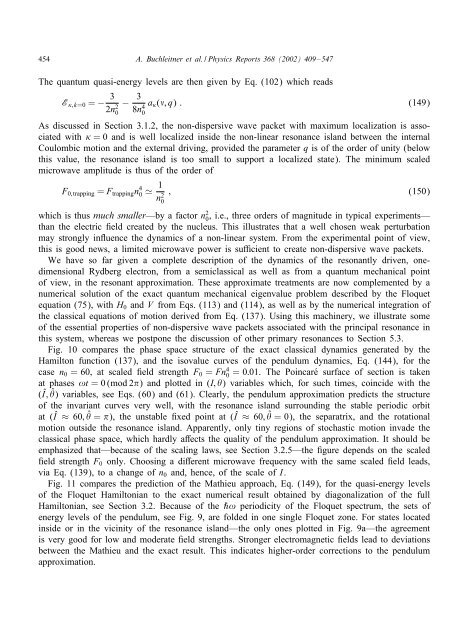Non-dispersive wave packets in periodically driven quantum systems
Non-dispersive wave packets in periodically driven quantum systems
Non-dispersive wave packets in periodically driven quantum systems
Create successful ePaper yourself
Turn your PDF publications into a flip-book with our unique Google optimized e-Paper software.
454 A. Buchleitner et al. / Physics Reports 368 (2002) 409–547<br />
The <strong>quantum</strong> quasi-energy levels are then given by Eq. (102) which reads<br />
E ;k=0 = − 3<br />
2n2 −<br />
0<br />
3<br />
8n4 a ( ; q) : (149)<br />
0<br />
As discussed <strong>in</strong> Section 3.1.2, the non-<strong>dispersive</strong> <strong>wave</strong> packet with maximum localization is associated<br />
with = 0 and is well localized <strong>in</strong>side the non-l<strong>in</strong>ear resonance island between the <strong>in</strong>ternal<br />
Coulombic motion and the external driv<strong>in</strong>g, provided the parameter q is of the order of unity (below<br />
this value, the resonance island is too small to support a localized state). The m<strong>in</strong>imum scaled<br />
micro<strong>wave</strong> amplitude is thus of the order of<br />
F0;trapp<strong>in</strong>g = Ftrapp<strong>in</strong>gn 4 0 1<br />
n2 ; (150)<br />
0<br />
which is thus much smaller—by a factor n2 0 , i.e., three orders of magnitude <strong>in</strong> typical experiments—<br />
than the electric eld created by the nucleus. This illustrates that a well chosen weak perturbation<br />
may strongly <strong>in</strong> uence the dynamics of a non-l<strong>in</strong>ear system. From the experimental po<strong>in</strong>t of view,<br />
this is good news, a limited micro<strong>wave</strong> power is su cient to create non-<strong>dispersive</strong> <strong>wave</strong> <strong>packets</strong>.<br />
We have so far given a complete description of the dynamics of the resonantly <strong>driven</strong>, onedimensional<br />
Rydberg electron, from a semiclassical as well as from a <strong>quantum</strong> mechanical po<strong>in</strong>t<br />
of view, <strong>in</strong> the resonant approximation. These approximate treatments are now complemented by a<br />
numerical solution of the exact <strong>quantum</strong> mechanical eigenvalue problem described by the Floquet<br />
equation (75), with H0 and V from Eqs. (113) and (114), as well as by the numerical <strong>in</strong>tegration of<br />
the classical equations of motion derived from Eq. (137). Us<strong>in</strong>g this mach<strong>in</strong>ery, we illustrate some<br />
of the essential properties of non-<strong>dispersive</strong> <strong>wave</strong> <strong>packets</strong> associated with the pr<strong>in</strong>cipal resonance <strong>in</strong><br />
this system, whereas we postpone the discussion of other primary resonances to Section 5.3.<br />
Fig. 10 compares the phase space structure of the exact classical dynamics generated by the<br />
Hamilton function (137), and the isovalue curves of the pendulum dynamics, Eq. (144), for the<br />
case n0 = 60, at scaled eld strength F0 = Fn4 0 =0:01. The Po<strong>in</strong>care surface of section is taken<br />
at phases !t = 0 (mod 2 ) and plotted <strong>in</strong> (I; ) variables which, for such times, co<strong>in</strong>cide with the<br />
(Î; ˆ ) variables, see Eqs. (60) and (61). Clearly, the pendulum approximation predicts the structure<br />
of the <strong>in</strong>variant curves very well, with the resonance island surround<strong>in</strong>g the stable periodic orbit<br />
at (Î ≈ 60; ˆ = ), the unstable xed po<strong>in</strong>t at (Î ≈ 60; ˆ = 0), the separatrix, and the rotational<br />
motion outside the resonance island. Apparently, only t<strong>in</strong>y regions of stochastic motion <strong>in</strong>vade the<br />
classical phase space, which hardly a ects the quality of the pendulum approximation. It should be<br />
emphasized that—because of the scal<strong>in</strong>g laws, see Section 3.2.5—the gure depends on the scaled<br />
eld strength F0 only. Choos<strong>in</strong>g a di erent micro<strong>wave</strong> frequency with the same scaled eld leads,<br />
via Eq. (139), to a change of n0 and, hence, of the scale of I.<br />
Fig. 11 compares the prediction of the Mathieu approach, Eq. (149), for the quasi-energy levels<br />
of the Floquet Hamiltonian to the exact numerical result obta<strong>in</strong>ed by diagonalization of the full<br />
Hamiltonian, see Section 3.2. Because of the ˝! periodicity of the Floquet spectrum, the sets of<br />
energy levels of the pendulum, see Fig. 9, are folded <strong>in</strong> one s<strong>in</strong>gle Floquet zone. For states located<br />
<strong>in</strong>side or <strong>in</strong> the vic<strong>in</strong>ity of the resonance island—the only ones plotted <strong>in</strong> Fig. 9a—the agreement<br />
is very good for low and moderate eld strengths. Stronger electromagnetic elds lead to deviations<br />
between the Mathieu and the exact result. This <strong>in</strong>dicates higher-order corrections to the pendulum<br />
approximation.











